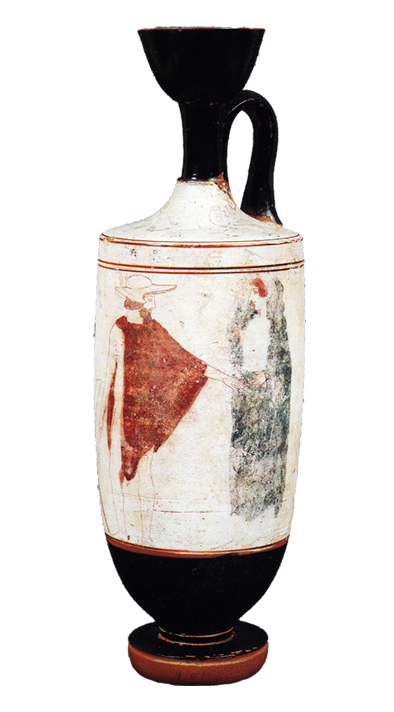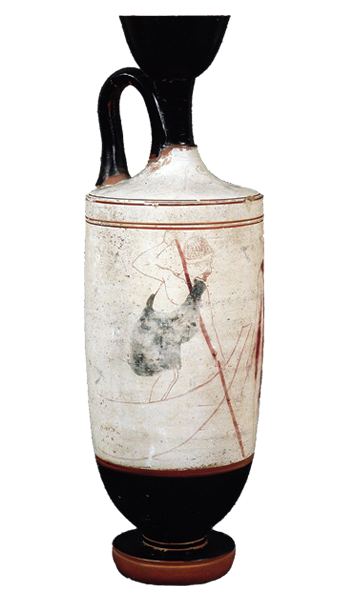Exhibit of the month
The garment of death …
Attic white-ground lekythos attributed to the Sabouroff Painter
National Archaeological Museum
Vase and Minor Arts Collection, inv. no A1926
Provenance: Eretria
Dimensions: Height: 31.6 cm
Date: 440-430 BC
Display location: Vase Collection, Room 55, Showcase 110
The vase illustrates one of the most characteristic representations found on white-ground lekythoi, the delivery of a woman to Charon by Hermes Psychopompos (“the guide of souls”).
The scene takes place on the shores of Lake Acherusia. Charon is shown standing inside his boat which he keeps in place by fixing his pole onto the shore. Even though in literary sources Charon is described as an elderly man, in white-ground lekythoi he is depicted at various ages and with different facial features. In this case, he takes the form of a man of toil and a slave. He is dressed in their most characteristic garb, the exomis, namely a chiton fastened over the left shoulder, wearing the leather cyne, a cap made of dog’s skin.
Hermes is depicted as a chthonic god and the consoling escort who becomes the link between the two worlds, the world of the living and that of the dead. He wears red chlamys and petasos on his head, the characteristic wide-brimmed travellers’ hat. The god turns towards the young woman to the right and with a gesture of his left hand he encourages her to board Charon’s boat. In his lowered hand he holds kerykeion (herald’s wand), as if he is pointing imperatively at the road to Hades.
The woman, like a bride of the Underworld, is clad in festive clothes, chiton and himation. She calmly lifts the edge of her dark-coloured himation with a gesture associated with anakalypsis, namely the revelation of the face of the bride in nuptial scenes. Although dead, she preserves her facial features, in contrast to the swarm of souls who come from the Underworld to welcome her.
Three figures, three different attires typical of the ancient Athenians. A divine wayfarer, a young woman who passed away prematurely, a bride of the Underworld, and Charon represented as a man of toil.
Dr Georgios Kavvadias
Bibliography:
Γ. Καββαδίας, Ο Ζωγράφος του Sabouroff, Αθήνα 2000, 128-130, pl. 3 and 201.
E. Walter-Karydi, Die Athener und ihre Gräber (1000-300 v. Chr., Berlin, 2015, p. 142, fig.75.




